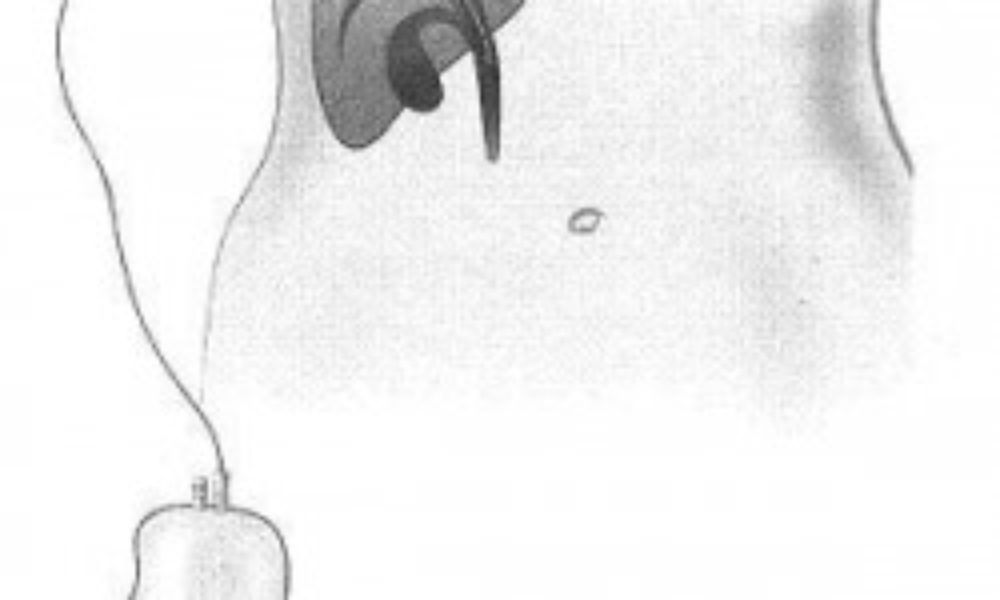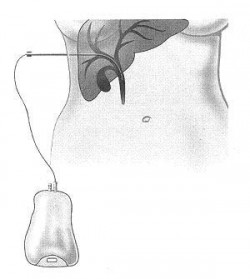Inserting a bilary stent with a PTC
This is like an ERCP in that a dye is used to see any obstruction on an x-ray.
Percutaneous Transhepatic Cholangiogram (PTC)
Instead of inserting a tube with an endoscope, a needle is inserted through the skin between your ribs and a very thin wire passed through the liver and through the blockage in the bile duct. A stent is then fed along this wire.
You will be given advice about eating and drinking before your procedure, but it is likely that you won’t be able to eat or drink anything for six hours beforehand. You may be given a local or general anaesthetic so that you don’t feel any pain as the needle is passed through the skin. If you have a local anaesthetic, you may also be given sedation to ensure that you feel no discomfort as the needle is positioned correctly. You will be given antibiotics before and after your PTC to prevent infection.
How will I feel afterwards?
After your procedure you will need to lie flat in bed for around six hours. You will need to stay in hospital for a few days. You may have had a temporary drain to help bile flow again after your procedure which will be removed before you are discharged home.
How will I know if the stent is working or blocked?
You should feel your jaundice symptoms start to improve after a few days and after two to three weeks your symptoms should have gone. You will have blood tests to ensure that the bilirubin (yellow pigment) causing the jaundice is
gone. Once your levels are back to normal you will be able to start chemotherapy or radiotherapy.
If you think your stent is blocked it is important that you contact your GP, hospital doctor or specialist nurse immediately. Make sure you have their phone numbers to hand. Signs of a blockage include jaundice, right upper stomach pain, feeling hot and cold with episodes of severe shivering (rigours), dark urine or pale bowel movements.
If you think your stent is blocked it is important that you contact your G.P., hospital doctor or specialist nurse immediately. Make sure you have their phone numbers handy.

The PTC method is similar to ERCP in that a dye is used to show up the obstruction on X-ray. Instead of the tube being inserted through an endoscope, a needle will be inserted through the skin just below your rib cage and a fine guide-wire passed through the liver and into the blockage in the bile duct. The stent is then passed along this wire.

What happens during a PTC?
As with ERCP, you must not eat or drink anything for at least six hours beforehand. You will have some sedation and you will also have a local anaesthetic so you should not feel pain as the needle or wire is passed through the skin. Some people find that moving the wire into the correct position in the bile duct can be quite uncomfortable and some sedation is usually given. To prevent any infection you may be given antibiotics before and after the procedure.
After your PTC you will need to lie flat in bed for six hours. It is likely you will stay in hospital for a few days afterwards until everything settles down.
What happens if the stent becomes blocked?
Signs that indicate that the stent could be blocked are:
- You become jaundiced again.
- You may feel hot and cold with episodes of severe shivering – these episodes are known as “rigors”.
- Your urine becomes dark.
- Your bowel motions become pale.
N.B If you think your stent is blocked it is important that you contact your G.P., hospital doctor or specialist nurse immediately. Make sure you have their phone numbers handy
 The information provided in this site, or through links to other websites, is not a substitute for medical or professional care and should not be relied upon as such. Read our disclaimer.
The information provided in this site, or through links to other websites, is not a substitute for medical or professional care and should not be relied upon as such. Read our disclaimer.
Sources and references for this information product will be supplied on request. Please contact us quoting the Information Product number below:
| Information Product № | PCA0013 v1 | Published | 15/10/2019 |
|---|---|---|---|
| Last Updated | 18/03/2022 | Next Review Due | 01/03/2017 |